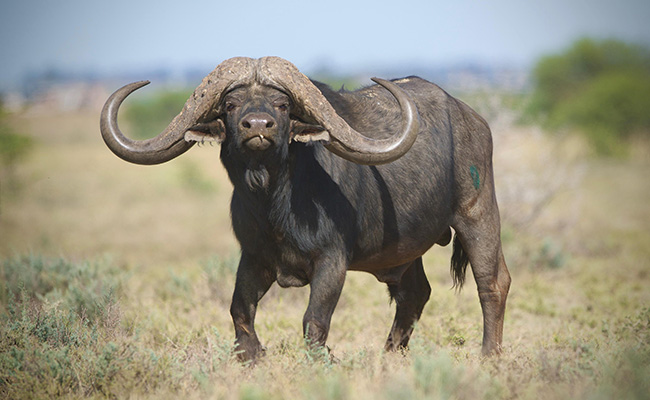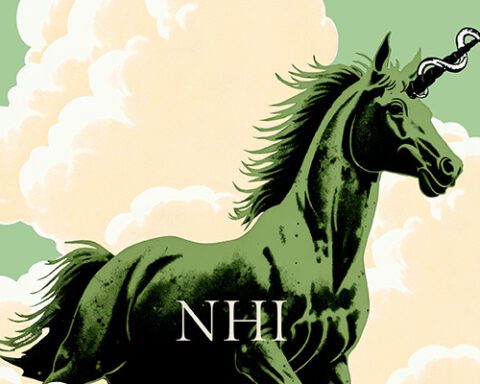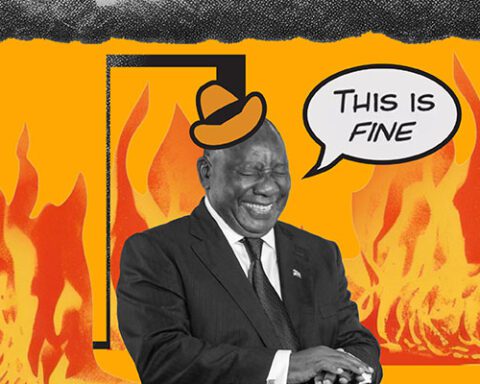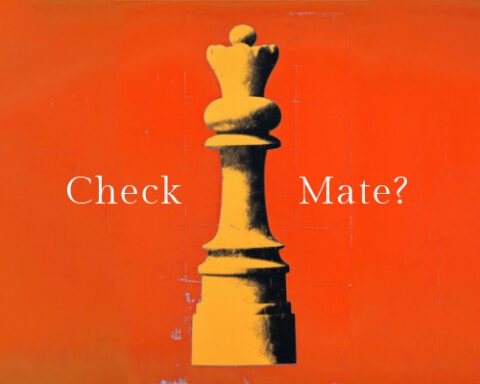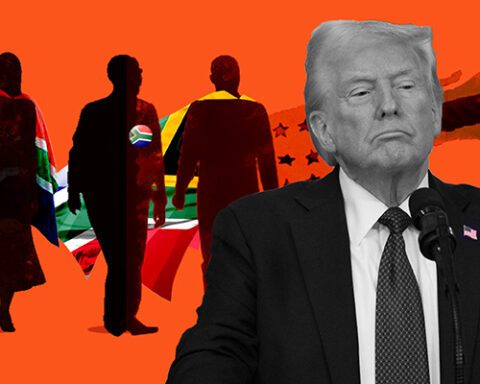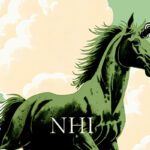Two huge LED screens, framed by bright green LEDs blinking in sync with booming speakers fill the marquee with powerful sound, towering imposingly over the standing room-only Piet du Toit Wildbedryf auction on Saturday February 15.
A massive, majestic buffalo bull appears on-screen while in front of the auctioneer’s stage, flame bursts reach up almost to the roof. The bull snorts, mock-charges the camera and shakes its formidable horns, holding the audience spellbound. Outside, a welcome drizzle continues, much to everyone’s delight.
When the music fades, the video makes room for a catalogue of the bull’s impressive stats, including his exceptional horn spread of 56 inches and an (unofficial) Safari Club International world record measurement of 154 inches. In layperson terms, this simply means his horns are big, bigger than any other buffalo ever measured. And after some spirited bidding from many interested buyers, ace auctioneer Brandon Leer’s hammer falls on the winning R22m.
Eventually the auction reaches a total turnover of R82m, announcing that things are back to normal in the wildlife industry after a deep recession over the Covid period.
Earlier in the day, Piet du Toit opened proceedings by inviting agriculture minister John Steenhuisen to the stage. Steenhuisen, in turn, remarked that it’s not every day that he addresses an auction room full of farmers with Julius Malema in the audience. That’s true. There’s Steenhuisen on stage, the EFF’s Malema in the VIP section at the back of the marquee, and a room full of wildlife farmers and enthusiasts, all against the backdrop of Donald Trump’s controversial remarks on land expropriation. What a country we live in, right?
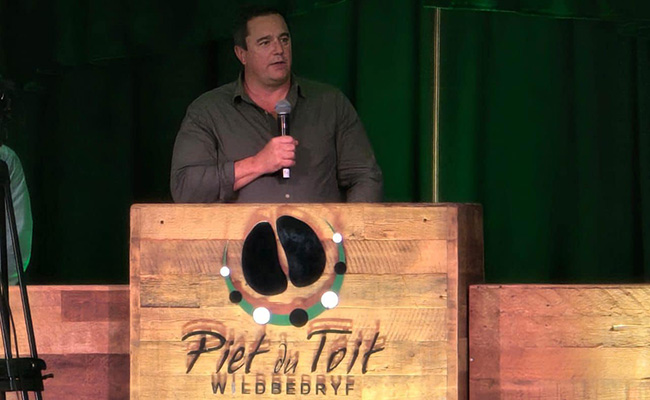
High-end studs
The biennial Piet du Toit auction is a prominent indicator of the health of the high-value stud breeding sector of the wildlife industry.
“Piet’s auction stands out because he and his guest sellers offer the finest animals,” says JP Smith, chief operating officer of Wildswinkel Veilings, the auction house responsible for managing the auction’s buying and selling platform. “Breeders know that when they buy on this auction, their own herds will benefit from an injection of super genetics for long-term improvement, irrespective of the species bought.”
Superior traits like longer horns, better colouring and stronger builds are a key factor for top breeders, like Richard Morton from Tembani Wildlife. “This is why demand is so high. Breeders want to continuously improve their own herds by injecting new genetics of quality.”
But Smith warns against simply using total auction turnover as an indicator of success: “To provide a practically useful indication of the health of the wildlife breeding sector, we remove outliers to calculate average lot prices across all species offered. Excluding the record-breaking buffalo and a few other top-tier animals, the average lot price across species was around R400,000.”
While that sounds less impressive than millions for one animal, it’s actually indicative of a more mature market in better equilibrium. “The two previous eras of first, unrealistic prices driven somewhat by speculation, and the second, Covid-induced recession, seem to have now made way for a new stage of sustainability and realistic growth, driven by super quality genetics and high hunting industry demand,” says Smith.
For Du Toit, it means the wildlife industry is no longer in a so-called artificial state. “Prices for regular animals on auction across species are now at sustainable, stable levels that make it economically viable to purchase and sell animals that deliver enough income for a viable wildlife business,” he says.
The good news is that demand from the end-consumer, which is the hunting industry that includes the trophy and biltong sectors, as well as all the associated industries of accommodation, transportation, taxidermy and the like “is strong and growing”.
“I’ve recently spoken to 30 or more of our biggest hunting operators who mostly concentrate on the overseas hunting market. They all expect a fantastic year. Most are fully booked for 2025.”
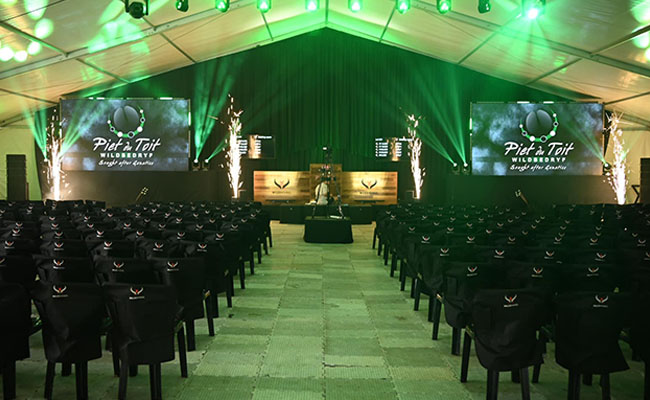
Crucial role
But where was super fan Cyril Ramaphosa? Du Toit says he spoke to the President the day before the auction, en route to Ethiopia. He mentioned that Steenhuisen was going to speak before the auction, to which the president remarked that Steenhuisen “is a very dedicated minister”.
Says Du Toit: “To me dedication means that he fights for agriculture. [Steenhuisen] reassured us that the wildlife industry is an important part of the agricultural sector. After his speech there was a great vibe among the audience. It reinforced our sense of purpose and the wildlife industry’s crucial role in the country’s economy.”
Pieter Ernst Jnr from the Bona Bona wildlife and hunting group argues that strong demand from the hunting industry is key to a sustainable future for the wildlife sector in general. “That is why we have a breeding and hunting operation, like many of our peers. In our hunting business this translates into financial management based on local prices. We base our operations on the value that hunters place on a trophy.”
Ernst expects hunting buffalo prices to follow the trend seen with sable antelope – that is, to start dropping over time. “Naturally, as demand outstrips supply again in future, we’ll see market forces come in to play and hunting buffalo prices will trend upwards again. This is the normal market at work, which supports my belief that we’re in a positive, sustainable phase in the wildlife industry.”
Veteran farmer Jacques Malan from Lumarie outside Bela-Bela is enthusiastic about the stud wildlife sector’s success in breeding ever better-quality animals. “Over time, our wildlife sector, like the cattle or sheep sectors, has steadily improved the quality of male and female animals for all species.” To use sables as an example, “horn lengths have grown from about 44 inches for top animals to 50 inches or more. Currently there are three sable bulls that measure above 60 inches. This phenomenal increase in quality has made our wildlife industry a standout success. We’re all extremely proud of it and will continue to do our best to improve further.”
According to Wildswinkel’s Smith, wildlife’s contribution to the overall agricultural sector was R17bn in 2023, based on the latest available figures from Stats SA. “This accounts for 10% of agriculture’s total contribution across the value chain. It highlights the significant role our farmers and related businesses play in the sector and the country’s GDP. This year could be even better due to the expected growth in overseas hunters visiting us, as well as a healthy, stable, positive breeding sector,” he says.
The Piet du Toit auction underscores a dynamic resurgence in the wildlife industry. And with a focus on premium genetics, a matured market and an enthusiastic response from important players, like the state, the industry is poised for a period of sustainable growth.
This is a guest column by Louis Eksteen, co-founder of marketing agency Twisted Toast Digital, who has a decade’s experience working in the wildlife sector on behalf of his agency’s clients.
Sign up to Currency’s weekly newsletters to receive your own bulletin of weekday news and weekend treats. Register here.
